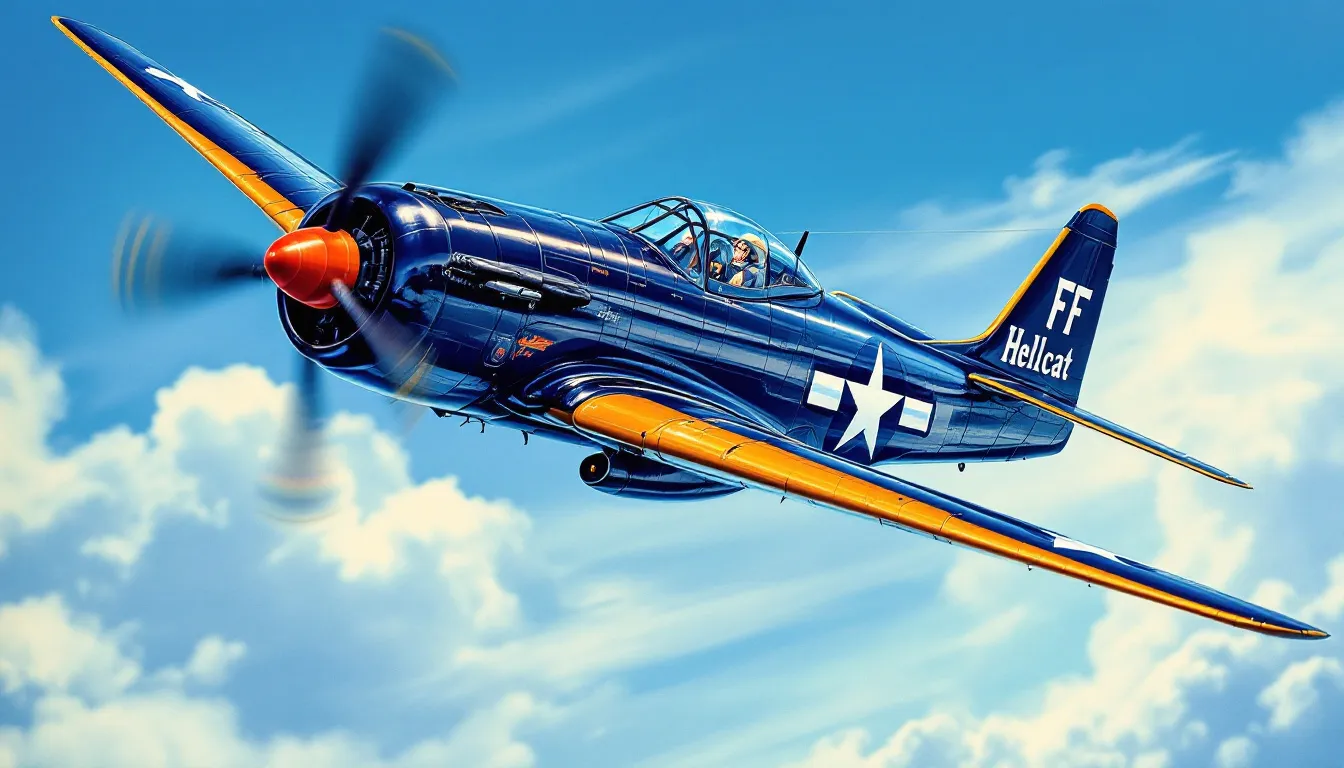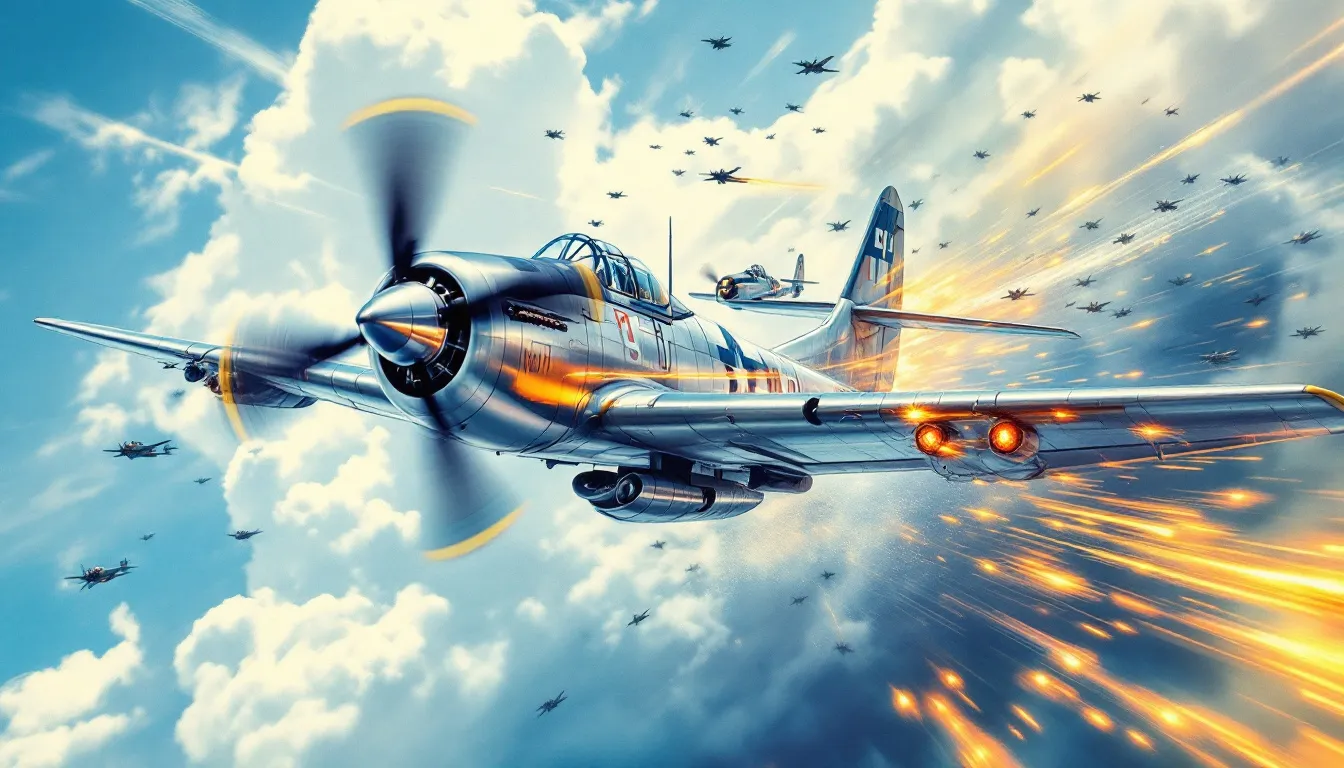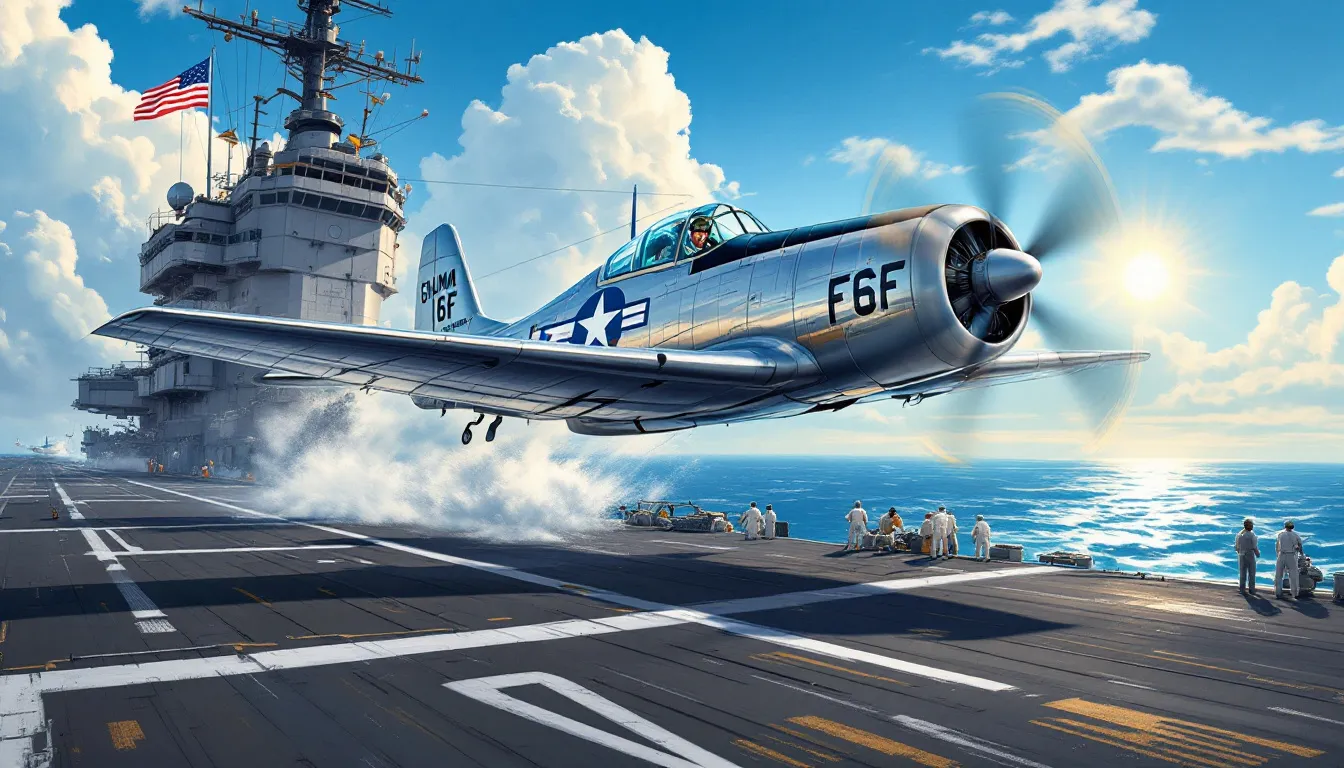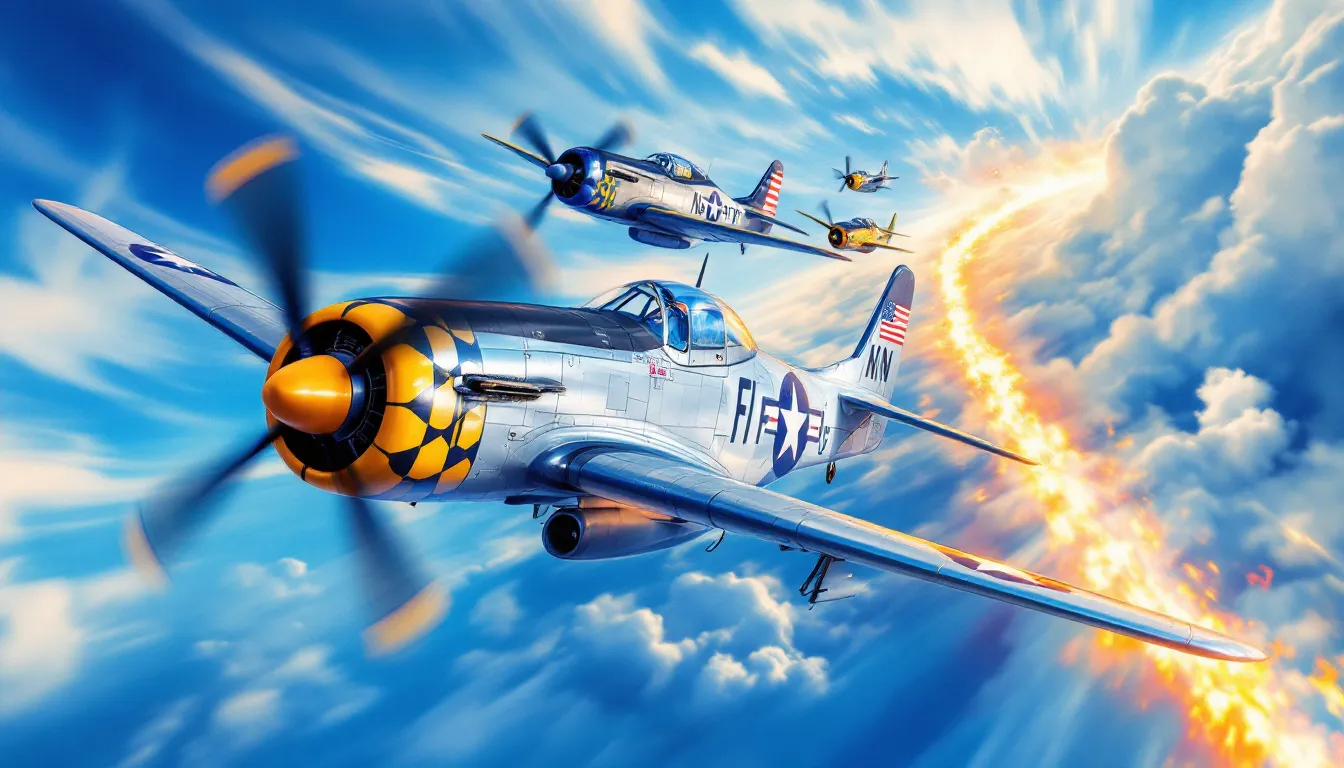The Legendary F 6 Hellcat: WWII's Dominant Fighter
The F 6 Hellcat was a key U.S. Navy fighter in World War II. Built by Grumman, it was known for its durability and effectiveness in combat. This article explores its design, combat role, and historical impact.
Key Takeaways
-
The Grumman F6F Hellcat, introduced in 1942, became the backbone of U.S. carrier aviation due to its innovative design and robust performance.
-
With a remarkable kill-to-loss ratio of 19:1, the Hellcat was pivotal in achieving Allied air superiority during World War II, particularly noted for its role in the Battle of the Philippine Sea.
-
The Hellcat’s exceptional design for carrier operations, including features like hydraulically operated landing gear and ‘Sto-Wing’ technology, solidified its status as a reliable and vital asset for the U.S. Navy.
The Rise of the F 6 Hellcat

The Grumman F6F Hellcat, a carrier-based fighter aircraft, first took to the skies in 1942, marking the beginning of a new era in naval aviation. Developed by Grumman for the U.S. Navy, the Hellcat quickly became the backbone of U.S. Carrier aviation by 1944, thanks to its superior performance and reliability.
The Hellcat’s rise involved innovative design features and overcoming significant development challenges. Its journey from prototype to frontline service was remarkably swift—even by wartime standards.
From Blueprint to Battle: Rapid Development
Work on the Hellcat began in mid-1941, with Grumman’s G-50 design, designated XF6F-1, making its first flight in June 1942. The initial prototype was powered by a 1,700-horsepower Wright R-2600-10 engine, but designers soon opted for the more powerful 2,000-horsepower Pratt & Whitney R-2800-10. This upgrade led to the XF6F-3, which first flew in July 1942. The successful trials prompted an immediate contract for mass production.
A testament to wartime urgency, the first production F6F-3 took flight in October 1942. Deliveries to front-line squadrons began in early 1943, and the Hellcat’s combat debut came just 18 months after the first prototype, during an August 1943 raid on Marcus Island by Fighting Squadron (VF) 5 operating from the USS Yorktown (CV-10).
By 1944, the Hellcat had become the Navy’s standard carrier-based fighter. In a remarkable feat of production, Grumman built 4,403 F6F-3s, including specialized night fighters and photo-reconnaissance variants. The Royal Navy also adopted the Hellcat, reflecting its widespread appeal and reliability.
Design Innovations
Grumman aimed for the F6F Hellcat to outperform earlier naval fighters and remedy past shortcomings. One of the standout features was the robust landing gear, which significantly improved the Hellcat’s landing and takeoff capabilities on aircraft carriers. This feature allowed Hellcat pilots to operate confidently under the demanding conditions of carrier operations.
Effective cockpit armor was another significant advancement, enhancing pilot protection during combat. Additionally, the Hellcat’s hydraulically operated landing gear and folding wings were significant upgrades over earlier models, facilitating easier storage and maintenance on crowded carrier decks. Collectively, these innovations solidified the Hellcat’s reputation as a formidable and reliable fighter.
Continuous Improvement and Production Feats
The development didn’t stop with the F6F-3. In 1944, the F6F-5 variant entered service, bringing refinements such as a streamlined cowling, improved windshield, and the ability to carry a 2,000-pound bomb on the centerline. Some models were equipped with rocket rails or upgraded wing armament—two 20mm cannons and four .50-caliber machine guns—giving the Hellcat even greater firepower. Production numbers soared: 6,681 F6F-5s were built, including night-fighter and reconnaissance versions.
Altogether, Grumman produced 12,275 Hellcats in just 30 months—an astonishing achievement, especially considering that much of the assembly plant was still being constructed as the first aircraft rolled off the line.
Development Challenges
The development of the F6F Hellcat faced several challenges despite its eventual success. The production capacity was stretched thin, necessitating the use of facilities and resources from other Grumman aircraft, which impacted the timeline of the Hellcat’s development. Moreover, the F6F Hellcat’s development was expedited due to the initial difficulties faced by the F4U Corsair during its production phase.
These challenges underscored the importance of the Hellcat’s timely and efficient production to meet the urgent demands of WWII.
Dominance in Aerial Combat

The F6F Hellcat earned its place in history through its dominance in aerial combat during World War II. Renowned for its remarkable combat record, the Hellcat played a crucial role in achieving Allied air superiority. It is celebrated for its impressive kill-to-loss ratio and its significant contributions to the Allies’ victories in the Pacific theater.
Notably, the Hellcat excelled against its most formidable adversary, the Japanese A6M Zero. Outperforming this legendary fighter, the F6F accounted for 5,156 enemy aircraft destroyed—an astonishing figure that comprised 75 percent of the U.S. Navy’s total air-to-air victories during the war. These numbers underscore just how central the Hellcat was to the Navy’s aerial dominance.
The Hellcat’s key battles and exceptional combat statistics highlight its dominance.
Battle of the Philippine Sea
In June 1944, the Battle of the Philippine Sea marked a turning point in naval aviation, and the Hellcat was at the forefront of this decisive engagement. The battle saw the U.S. Navy eliminate Japan’s ability to conduct large-scale carrier operations, with Hellcat pilots playing a pivotal role in this victory. American pilots achieved a staggering success, downing approximately 480 Japanese aircraft, with the Hellcat being a key contributor to this achievement.
The Hellcat’s role in the Battle of the Philippine Sea highlighted its superiority over Japanese aircraft. Its robust design, advanced armament, and the skill of its pilots ensured that the U.S. Navy maintained air superiority throughout the engagement. This battle solidified the Hellcat’s reputation as a dominant fighter in the Pacific theater.
Combat Statistics
The combat statistics of the F6F Hellcat are nothing short of extraordinary. With a kill-to-loss ratio of 19:1, the Hellcat demonstrated its unmatched effectiveness in aerial engagements. This remarkable ratio meant that for nearly every American Hellcat lost, 19 enemy aircraft were shot down. Such a high kill ratio was a testament to the aircraft’s superior design and the skill of its pilots.
Throughout World War II, the Hellcat was responsible for destroying over 5,000 enemy aircraft, accounting for 75 percent of the U.S. Navy’s air-to-air victories during the war. Confirmed victories claimed by Hellcats exceeded 5,156, showcasing the aircraft’s critical role in securing air dominance.
Comparative Evaluations Late in the War
As World War II drew to a close, the U.S. Navy put the Hellcat through rigorous evaluations alongside other Allied aircraft and captured Axis fighters. Consistently, the F6F Hellcat emerged as a top performer, ranking at or near the summit in key criteria such as maneuverability, durability, and overall combat effectiveness. Its ability to outperform many of its contemporaries—some of which enjoyed longer and more methodical development cycles—underscored just how remarkable the Hellcat’s rapid engineering and design really were.
This impressive standing among both friend and foe further cemented the Hellcat’s legacy as one of the era’s truly elite fighters.
Carrier Operations

The F6F Hellcat was specifically engineered for the rigors of carrier operations, making it a vital asset onboard aircraft carriers. Its design emphasized straightforward maintenance and dependable performance, which were essential for the demanding conditions of naval aviation.
The Hellcat’s durable design and ease of maintenance made it one of the simplest WWII combat aircraft to service on carriers.
U.S. Navy Adoption
The U.S. Navy’s adoption of the Hellcat was driven by its superior performance and reliability compared to previous models. The Navy recognized the Hellcat as its main carrier fighter due to its effectiveness in countering the Japanese A6M Zero. By the end of World War II, Grumman had produced over 12,000 F6F Hellcats, underscoring the efficiency of its production process.
Remarkably, the Hellcat went from the experimental stage to operational employment in less than 18 months—a testament to the urgency and ingenuity of wartime innovation. The scale of production was equally impressive: in just 30 months, 12,275 Hellcats rolled off the lines at Grumman’s Bethpage Plant Number 3, with much of the factory itself still under construction as the first aircraft were being assembled inside. This rapid ramp-up ensured the Navy’s carrier decks were stocked with the Hellcat in time for critical battles across the Pacific.
The Hellcat first saw combat in September 1943, playing a crucial role in the Pacific theater.
The development of the F6F Hellcat faced several challenges despite its eventual success. The production capacity was stretched thin, necessitating the use of facilities and resources from other Grumman aircraft, which impacted the timeline of the Hellcat’s development. Moreover, the F6F Hellcat’s development was expedited due to the initial difficulties faced by the F4U Corsair during its production phase.
These challenges underscored the importance of the Hellcat’s timely and efficient production to meet the urgent demands of WWII.
Carrier Landings
The Hellcat’s design was optimized for the challenges of carrier landings. Its robust structure and effective engine significantly facilitated landing procedures on aircraft carriers. The landing gear was engineered to absorb the impact during carrier landings, enhancing the Hellcat’s operational reliability. Features such as larger wings and a durable design allowed the Hellcat to handle the stresses of carrier landings effectively.
One of the Hellcat’s notable innovations was the ‘Sto-Wing’ design, which allowed its wings to fold up. This feature was crucial for maximizing space on crowded carrier decks. It also featured a bullet-resistant windscreen and armor for critical components like the oil tank, enhancing durability and protection in combat.
Technical Specifications
The F6F Hellcat’s technical specifications highlight its powerful performance and robust design. Powered by a Pratt & Whitney R-2800-10W engine producing 2,000 horsepower, the Hellcat was a formidable aircraft in World War II.
Development of the Hellcat began in mid-1941 with Grumman’s G-50 design, which was initially designated as the XF6F-1. The first prototype took flight in June 1942, originally equipped with a 1,700 horsepower Wright R-2600-10 engine. However, design changes soon prompted the fitting of the second prototype with the more powerful Pratt & Whitney R-2800-10 engine, offering a significant boost in performance. Just a month later, the upgraded XF6F-3 took to the skies for its first flight, and the aircraft’s impressive capabilities led to a rapid contract for large-scale production.
The Hellcat’s dimensions, weight, performance metrics, and armament are detailed here.
General Characteristics
Before: The Hellcat’s general characteristics are impressive. It has a length of 33 feet 7 inches, a height of 11 feet 1 inch, and a wingspan of 42 feet 10 inches. The aircraft’s empty weight is 9,023 pounds, while its gross weight reaches 15,413 pounds.
After: The Hellcat’s general characteristics are impressive:
- Length: 33 feet 7 inches
- Height: 11 feet 1 inch
- Wingspan: 42 feet 10 inches
- Empty weight: 9,023 pounds
- Gross weight: 15,413 pounds
These specifications reflect the Hellcat’s robust build, contributing to its combat effectiveness.
Performance Metrics
Before: The performance metrics of the F6F Hellcat are a testament to its superior engineering. The maximum speed of the Hellcat is 376 mph at an altitude of 23,400 feet, with the F6F-5 variant achieving a top speed of 391 mph. The aircraft could climb to 10,000 feet in about 3.1 minutes, showcasing its impressive climb rate. The Hellcat had a service ceiling of 38,000 feet, allowing it to operate at high altitudes.
After: The performance metrics of the F6F Hellcat are a testament to its superior engineering. Here are some key specifications:
- Maximum speed: 376 mph at an altitude of 23,400 feet
- F6F-5 variant top speed: 391 mph
- Climb rate: could reach 10,000 feet in about 3.1 minutes
- Service ceiling: 38,000 feet, allowing operation at high altitudes
The Hellcat’s range was equally impressive, with a combat range of 945 miles and a ferry range of up to 1,530 miles. Its cruise speed was 168 mph, making it a versatile aircraft for various missions. These metrics underscore the Hellcat’s ability to excel in varied combat scenarios, from dogfights to long-range missions.
Armament Details
The F6F Hellcat’s armament was designed to deliver substantial firepower. The primary armament consisted of six .50-caliber M2 Browning machine guns, each with 400 rounds. The F6F-5 variant included enhancements like increased firepower with two 20 mm cannons while maintaining the aircraft’s capabilities.
The Hellcat could also carry up to 4,000 pounds of bombs and rockets, boosting its strike capabilities.
Variants and Special Models

The F6F Hellcat was produced in various models, each designed to enhance its combat effectiveness. From the basic F6F-3 to the improved F6F-5 and specialized night fighter versions, these variants played crucial roles in different combat scenarios.
The main variants and their unique features are explored here.
F6F-3 and F6F-5
The F6F-3 was a significant improvement over the initial model, enhancing range and firepower. It featured a more powerful engine, increasing speed and operational capabilities. By 1944, the Hellcat had become the Navy’s standard carrier-based fighter, with Grumman producing 4,403 F6F-3s. Among these were 150 F6F-3N and F6F-3E night fighters and a number of F6F-3P photo-reconnaissance aircraft, reflecting the versatility and adaptability of the airframe.
Building on this success, the F6F-5 introduced further advancements, including an upgraded engine and improved avionics, which boosted performance and allowed for better altitude capabilities. The F6F-5 became operational in 1944 and incorporated a refined cowling and improved windshield for better pilot visibility. Notably, the F6F-5 added the ability to carry a 2,000-pound bomb on the centerline and was equipped with rocket rails under the wings, amplifying its ground attack potential.
Wing armament was updated on some F6F-5s, shifting from the original six .50-caliber machine guns to a combination of two 20 mm cannons and four .50-caliber machine guns. A total of 6,681 F6F-5s were produced, including 1,189 F6F-5N night fighters and a number of F6F-5P photo aircraft. These improvements contributed to the Hellcat’s dominance in the latter years of WWII.
Night Fighters
The development of night fighter variants like the F6F-5N was crucial for maintaining air superiority during nighttime operations in World War II. Equipped with advanced radar capabilities, these night fighters could effectively engage enemy aircraft in low-visibility conditions, proving vital in securing the skies during night raids.
The F6F-5N’s success showcased the Hellcat’s versatility and adaptability in different combat scenarios, and with over a thousand of these night fighters produced, they played a significant role in round-the-clock aerial operations.
British Hellcats
The British Royal Navy also recognized the value of the Hellcat, incorporating it into their fleet as the Grumman Gannet Mark I. Modifications were made to suit British operational requirements, including changes to instrumentation and systems.
In total, the Royal Navy procured 1,182 F6F-3 and F6F-5 aircraft, demonstrating the scale of their commitment to the type. British Hellcats achieved notable success during World War II, playing a key role in maintaining aerial superiority in maritime combat zones. Their integration into the Royal Navy highlighted the Hellcat’s international impact and versatility.
Legacy and Preservation

The legacy of the Hellcat is celebrated through various preservation efforts worldwide. Museums and aviation heritage organizations have worked tirelessly to restore and display these iconic aircraft, ensuring that future generations can appreciate their historical significance.
The Hellcat’s presence in notable museums and ongoing restoration projects keeps its legacy alive.
Museums and Collections
Several prestigious museums feature the Grumman F6F Hellcat in their collections, showcasing its historical importance. The National Air and Space Museum and the American Heritage Museum are among the institutions that display the Hellcat.
The Steven F. Udvar-Hazy Center in Chantilly, Virginia, also houses a Hellcat in its World War II Aviation exhibit, allowing visitors to get a close-up view of this legendary fighter. These exhibits preserve the Hellcat’s contributions to WWII aviation.
Restoration Projects
Restoration projects play a crucial role in preserving the Hellcat’s legacy. Organizations like the Erickson Aircraft Collection and the Yanks Air Museum have undertaken significant efforts to restore Hellcats to their former glory. The Air Zoo’s Hellcat restoration project is another example of the dedication to maintaining these historic aircraft.
These projects maintain the Hellcat as a tangible link to the past, inspiring aviation enthusiasts and historians.
Fun Facts and Trivia
The F6F Hellcat’s storied history is filled with fascinating facts and trivia. From its involvement in atomic bomb tests to its role as the first aircraft to join the Blue Angels flight demonstration team, the Hellcat’s legacy extends beyond its combat achievements.
Lesser-known aspects of the Hellcat’s history provide intriguing insights into this legendary aircraft.
Atomic Bomb Tests
In a remarkable testament to its durability, the F6F Hellcat was involved in atomic bomb tests at Bikini Atoll during Operation Crossroads. These tests were conducted to assess the effects of nuclear detonations on military assets, and the Hellcat’s resilience was put to the ultimate test.
The aircraft’s survival of atomic detonations further solidified its reputation as a durable and reliable fighter.
Final Flights
The final operational flights of the F6F Hellcat marked the end of an era. After World War II, the Hellcat transitioned from a combat aircraft to a cherished historical artifact. The final operational flight occurred in May 1961 at Point Mugu, California, signifying the end of its active service.
This transition allowed the Hellcat to take its place in history as a symbol of naval aviation excellence.
Summary
The Grumman F6F Hellcat remains one of the most iconic aircraft of World War II. Its remarkable design innovations, combat achievements, and enduring legacy make it a symbol of naval aviation excellence. From its development and design challenges to its dominance in aerial combat and pivotal role in key battles, the Hellcat’s story is one of resilience and triumph. The preservation efforts and restoration projects ensure that this legendary fighter continues to inspire future generations, reminding us of the bravery and ingenuity that defined an era.
Frequently Asked Questions
What made the F6F Hellcat a dominant fighter in WWII?
The F6F Hellcat's dominant status in WWII stemmed from its robust design, powerful armament, and superior performance, which, alongside skilled pilots, resulted in an extraordinary kill-to-loss ratio of 19:1. This combination ensured its effectiveness in aerial combat.
How many F6F Hellcats were produced during WWII?
Over 12,000 F6F Hellcats were produced by Grumman during World War II, showcasing the remarkable efficiency of their production methods.
What were the main differences between the F6F-3 and F6F-5 variants?
The main differences between the F6F-3 and F6F-5 variants lie in the F6F-5's upgraded engine, superior avionics, and enhanced performance capabilities, compared to the F6F-3's improved range and firepower.
How did the Hellcat perform in the Battle of the Philippine Sea?
The Hellcat was instrumental in the U.S. Navy's decisive victory at the Battle of the Philippine Sea, aiding in the destruction of around 480 Japanese aircraft. Its performance underscored its effectiveness as a carrier-based fighter.
Where can I see a preserved F6F Hellcat today?
You can see preserved F6F Hellcats at the National Air and Space Museum, the American Heritage Museum, and the Steven F. Udvar-Hazy Center. Each of these locations features this historic aircraft for public viewing.







